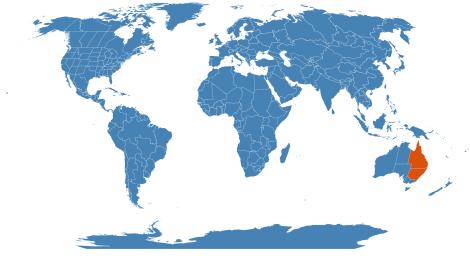Accession Data
Casuarina glauca
Common Name: Swamp She Oak
Family: Casuarinaceae
Country of Origin: Australia - narrowly defined along eastern coast
Description: Erect tree 10–15 (-30) m tall, the main stem moderately straight, often buttressed and fluted, the bark often cracked and flaky, the crown relatively sparse and narrow. Slender deciduous branchlets (ca 1 mm diameter) have 9–20 leaf teeth in remote whorls, short and broad, always tightly appressed. Male spikes dense, 1–2 1/2 cm long. Cones more or less cylindrical, ca 1–2 cm in diameter, much broader than long; valves 3–5 mm wide, in only 2 or 3 wheel-like rows. Seeds ca 700,000–970,000/kg.
Found in a narrow belt hugging the coast of eastern Australia from Bega in New South Wales to Rockhampton in Queensland. It has also been successful in the marshes and saline soils of Israel, Cyprus, India, Kenya, Malawi, South Africa, Florida, and Egypt. Most common at edges of swampy flats near estuaries and tidal rivers; sometimes found on or near beach fronts. The flats may be only marginally above tidal limits; the water table is usually close to the surface (often with 30 cm of the surface).
It grows naturally on estuarine plains that are flooded with brackish tidal water, and also thrives on dunes at the seaside, often in the path of ocean spray. Ranges from sea level to 900 m in Hawaii. Reported to tolerate annual precipitation of 5 to 40 dm, estimated annual temperature of 18 to 28°C, and pH of 5 to 8. Rarely tolerates temperatures lower than -3°C. It has grown in Israel under a soil crust of salt (50,000 ppm). Although most natural stands are on acidic soils, it has grown well on alkaline clay-loam soils with shallow water tables in hot, semiarid areas of Central Australia. Thailand seedlings have tolerated high Ca levels and as much as 30% limestone. In southern Florida it flourishes on oolitic limestone. In Hawaii it is frequently planted on much weathered parent basalt in eroded blowouts, sometimes in holes blasted by dynamite. It also does well in pure limestone sand (NAS, 1983e).
Roots are colonized by actinorhizal N-fixing bacteria Frankia.
Accession Data
Accession #: 200400245
Accession Date: 2004-10-25 00:00:00
Bloom Status: 🪴 Not Flowering
Location: 2312
Quantity: 2
Source: David Benson (MCB)
Classification
Division: Magnoliophyta
Class: Magnoliopsida
Subclass: eurosid I
Order: Fagales
Family: Casuarinaceae
References
-
Frankia Homepage
- New Crops Web Page @ Duke. Last accessed on Friday, January 15, 2016.
- The Plant List (2013). Version 1.1. Last accessed on Friday, February 09, 2018.
- WCSP (2017). World Checklist of Selected Plant Families. Facilitated by the Royal Botanic Gardens, Kew. Last accessed on Friday, February 09, 2018.
Images

